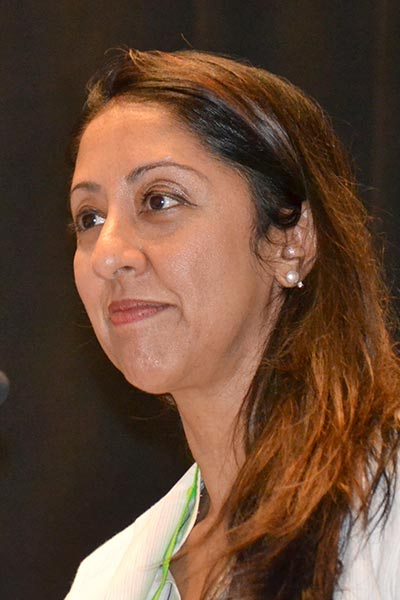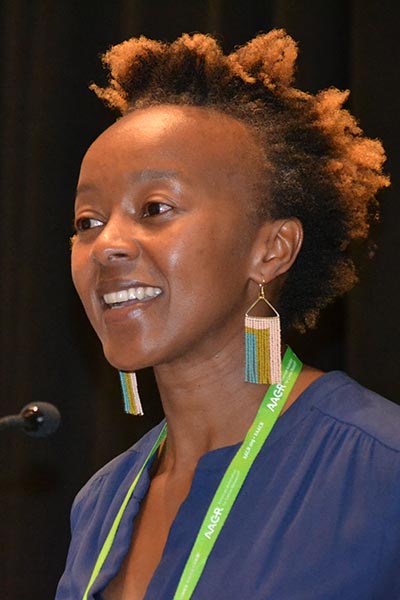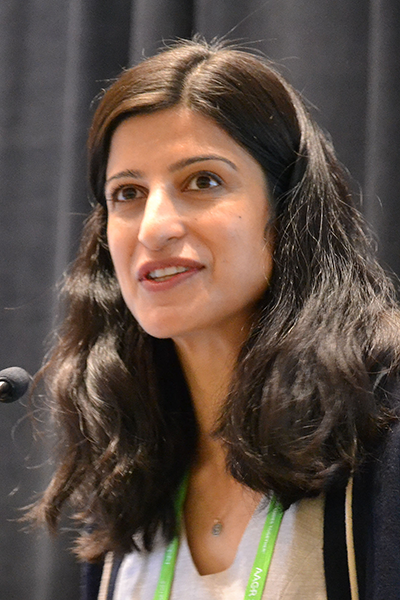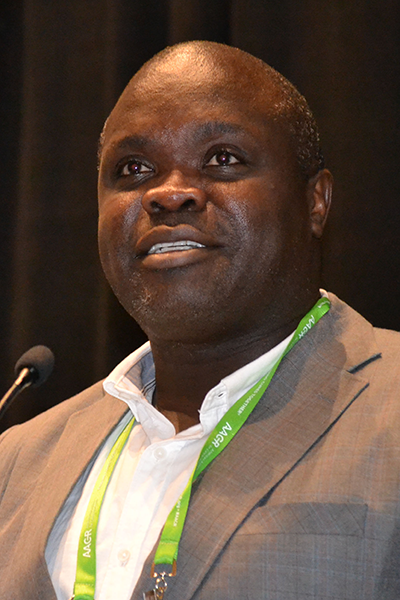International physician-scientists address global cancer burden
Cancer is projected to become the leading cause of global mortality within the next decade, and more than 75 percent of those deaths will be in lower- and middle-income countries (LMICs).

“Countries with a lower human-development index bear a double burden,” explained Sharmila Anandasabapathy, MD, Professor of Gastroenterology and Vice President of Global Health at Baylor College of Medicine. “They are picking up our bad habits — inactivity, weight gain, smoking — leading to more breast cancer, lung cancer, and esophageal adenocarcinoma. At the same time, persistent levels of infection and poverty contribute to high levels of cervix, liver, gastric cancers, and esophageal squamous cell carcinoma. These countries that bear the greatest burden of cancer are also the least well-equipped to prevent, detect, and treat cancer.”
Anandasabapathy moderated a symposium on the final day of the AACR Annual Meeting 2023 titled Global Cancer Burden: Challenges and Opportunities for Innovation. The session can be viewed on the virtual meeting platform by registered Annual Meeting participants through July 19, 2023.
Lack of infrastructure and geography inhibit access to screening and surveillance in LMICs, Anandasabapathy continued. The cancer workforce is small and scattered, access to vaccines and medications is difficult to nonexistent, clinical trials are few and far between, and the clinical infrastructure is both weak and poorly distributed, she said.
The World Health Organization (WHO) recommends implementation of early cancer detection and prevention programs at the primary care level, but most early detection tests are too complex and/or too costly for community-based care, particularly in medically underserved areas. Endoscopy is the gold standard for the diagnosis of esophageal cancer, for example, but less than half of hospitals in sub-Saharan Africa have usable endoscopes.
“Equipment must be robust, easy to repair, reusable, and usable off-grid,” Anandasabapathy said.
Baylor is working with partners in China and Brazil to develop a tethered capsule endoscope that is easy to swallow and easy to disinfect. Tablet-based capsules requiring less than $100 in parts can perform optical biopsies using high-resolution microendoscopy with 95 percent sensitivity and 79 percent specificity in academic centers. But specificity fell to 19 percent when used by novices in community health centers, prompting researchers to develop software-based detection.
“Our goal is to create a fully automated approach to providing a definitive diagnosis in real time with an opportunity to act and treat,” Anandasabapathy said. “Early detection and screening require tools and technologies that are cost-effective, environmentally and culturally appropriate, and actually used by real people in the real world.”
Cervical cancer is another disease exacerbated by health inequities. It’s almost totally preventable with early HPV vaccination or regular screening for unvaccinated women, yet there are about 600,000 new cases every year. Most of the new cases (85 percent) and mortality (90 percent) occur in LMICs.

“Where a woman lives determines whether or not she will get this disease,” said Chemtai Mungo, MD, MPH, Assistant Professor of Obstetrics and Gynecology at the University of North Carolina. “Cervical cancer is the leading cause of death for HIV-positive women in LMICs due to the failure of primary and secondary prevention.”
HIV infection increases the risk of cervical cancer five- to eight-fold, and women co-infected with HIV and HPV are younger at diagnosis and their cancers are more aggressive, Mungo said.
One approach to improve early detection and treatment is self-testing and self-treatment for HPV. Swab-based HPV testing is as accurate as pelvic exam testing, Mungo said, and early data show that self-treatment with 5-FU can effectively clear HPV infection.
Unblinded, randomized trials in HIV-positive and HIV-negative women found that 2 g of vaginal 5-FU self-applied biweekly for 16 weeks significantly reduced cervical cancer recurrence, improved regression in primary disease, and increased HPV clearance with no grade 3 or higher adverse events.
“5-FU is a WHO Essential Medication, generic, cheap, and available in LMICs,” Mungo said. “We hope to launch a pilot program in Kenya in the next few weeks to assess safety, uptake, and adherence. We expect to see no grade 3 or 4 adverse events, which will allow us to move into a randomized trial.”
The same gaps in prevention, early detection, and early treatment also plague later-stage treatment in LMICs.

“Africa has the highest burden of cervical cancer and the fewest resources to deal with it,” said Surbhi Grover, MD, MPH, Associate Professor of Radiation Oncology, Director of Global Radiation Oncology, and Oncology Lead in the Botswana-UPenn Partnership at the University of Pennsylvania Perelman School of Medicine. “Up to 70 percent of these cancers will require radiation therapy at some point, either for curative or palliative care. The regions and countries with the highest need for radiation therapy have the lowest access.”
There are five to seven radiation oncologists per 1,000 patients in the U.S., while most of Africa has less than one radiation oncologist per 1,000 patients, Grover said.
In 2015, Botswana created a multidisciplinary team (MDT) to address the problems of high patient loads, the lack of nurses and radiologists, poor medical records, overwhelmed pathology labs, low radiology capacity, chemotherapy stockouts, fragmented care, lack of follow-up, lack of clinical data, and lack of treatment guidelines. The MDT has halved the time from diagnosis to treatment from four months to two months, Grover reported.
A national data program found that 70 percent of cervical cancer patients in Botswana are HIV-positive and 75 percent have stage II or III disease at diagnosis. Overall survival at two years is 67 percent, and 56 percent at five years.
One surprising finding: Cervical cancer chemoradiation treatment outcomes were virtually identical for women with and without HIV. National data also showed significantly improved survival for high-dose therapy of >75 Gy versus lower-dose therapy of ≤75 Gy.
“This has helped us convince clinicians that women with HIV respond just as strongly as other women to higher dose, more effective radiation,” Grover said. “Five-year survival is the same regardless of HIV status.”
About 20 percent of women with cervical cancer are younger than 40 years of age, she continued, which supports WHO recommendations to begin cervical cancer screening at 25.

The overriding problem with cancer care in sub-Saharan Africa is a piecemeal approach, country by country, region by region, center by center, said Fredrick Chite Asirwa, MD, Director of the International Cancer Institute (ICI) in Eldoret, Kenya.
“We must be able to provide appropriate care to all patients,” Asirwa said. “Some countries do not even have cancer centers and some centers don’t have screening facilities, while some screening centers have no treatment. There is a mismatch in resources as well as insufficient resources.”
The ICI has developed a unified approach to care focused on clients, patients, and communities, Asirwa said. The approach includes:
- education and training for both communities and health-care providers
- community-based screening and early detection
- improved pathology services to improve diagnosis and treatment decisions
- improved access to therapies and palliative care
- better data and use of telemedicine resources
- improved access to research and clinical trials
- improved education for local and national leadership
- better engagement with policy and advocacy
- improved survivorship care and surveillance
“We have a paucity of data across Africa and telemedicine could help,” Asirwa said. “We also have a paucity of oncologists. With about 1 billion people, Africa has about 500 medical oncologists. We need more training and we need better retention of those who we train.”
Most oncology care in Africa is performed in siloes, Asirwa said. One approach to improve access is to break open those siloes. Instead of separate facilities for breast and cervical cancer screening, the ICI has pioneered integrated centers that provide breast and cervical cancer screening, as well as hypertension and diabetes testing and baseline mental health assessment.
“We have developed many good practices in oncology care around Africa, but successful programs and centers are scattered,” Asirwa said. “We can all improve the care we provide by working together and learning from each other instead of reinventing the wheel.”
More from the AACR Annual Meeting 2025
View a photo gallery of scenes from Chicago, continue the conversation on social media using the hashtag #AACR25, and read more coverage in AACR Annual Meeting News.

